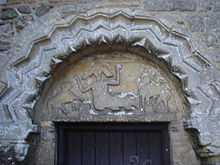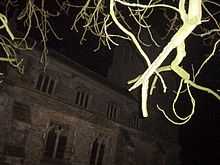Stow Longa

| Stow Longa | |
 Stow Longa | |
| OS grid reference | TL110715 |
|---|---|
| District | Huntingdonshire |
| Shire county | Cambridgeshire |
| Region | East |
| Country | England |
| Sovereign state | United Kingdom |
| EU Parliament | East of England |
| Website | http://www.stowlonga.org.uk |
| |
Stow Longa – in Huntingdonshire (now part of Cambridgeshire), England – is a village near Tilbrook west of Huntingdon and two miles north of Kimbolton. Stow Longa's original name was Stow or Long Stow, which comes from the Old English word stōw (meaning 'holy place') and the Latin word longa or Old English lang (meaning 'long'). Altogether, Stow Longa's name may mean 'the long holy place' or 'an extended settlement which is a holy place', though this is only a rough guess.
Stow was also thought to have been the name of the pre-Conquest estate, which, in the medieval period, was split between two parishes: one, Over Stow or Upper Stow, the western part, which belonged to the Kimbolton parish, and the other, Estou (also Nether Stow or Long Stow), the eastern part, which was part of the soke of Spaldwick.
Mistakenly described as a hamlet, it has the suitable number of houses and businesses to make it a village. Stow Longa is a village that is, at the current time, void of any street lamps, village shops, a school, a pub, and drains. However, Stow Longa does possess several thatched cottages, a village room, a blocked-up well (on the village green), a stone cross (discussed below) and mature elm trees that survived the Dutch Elm disease crisis.
According to a locally-published collection of short stories, 'Ploughing Songs' by Damian Croft,[1] the reason why the pubs that were in Stow Longa were closed down in the 1950s was because, "returning drovers used it to give a bad name to a few otherwise nameless women."
Early history
Before it was transferred to the Spaldwick parish in AD 991, the Stow estate had belonged to Brithnoth, Ealdorman of Essex, who died at the Battle of Maldon in AD 991. Brithnoth left his two estates, Spaldwick and Somersham, to the Abbot of Ely.[2]
Stow Longa's church


The Anglican church of Stow Longa is known as St Botolph's, since it is dedicated to St Botolph, which dates to the 13th century, though a stone slab with inter-laced works (probably pre-Conquest) on the south-side indicates an earlier date.
Though peaceful and fairly hidden today, the church in Stow Longa has had a remarkable history. Stow Longa was confirmed a prebend by Pope Eugene III on the 6th February 1146, and again by Pope Alexander III on the 5th January 1163.[3] A minster or mother-church of the local estate (which included Stow Longa, Spaldwick, Easton, Little Catworth, Barham and Upthorpe) before its importance was subsumed by Spaldwick and Kimbolton, St Botolph's wealth and importance attracted noted figures to the prebendary, such as Thomas Wolsey, who was Stow Longa's prebend from 1509 to 1514.
Above the priest door, outside the east side of the church, is the nationally famous stone carving known as the Mermaid Stone (or the Beckoning Mermaid Stone), since the engraving displays a mermaid between two creatures. According to one source, the creature on the right of the mermaid represents the crocodile (a creature of damnation) and the creature on the left of the mermaid, though on our right, represents the lamb, i.e. the Lamb of God (Jesus Christ). An alternative interpretation of the Mermaid Stone could be:
- Sins - the mermaid represents the sin of lust, whilst going in the direction of the beast on her right (representing hell) and turning her back against the beast on her left (representing the Kingdom of God).
- Anti-Paganism - even though this interpretation has no real backup, the Mermaid Stone may represent (based on the fact that a stream passes by the church) the struggle between Goddess worship (who may be either a river deity or whose attributes are scourned as lustful) - going towards Hell and leaving Christ - and the emerging Christian religion.
The village green cross
The common misinterpretation of the cross is that it was a marker point of where the coffin of Catherine of Aragon rested, after she died at nearby Kimbolton Castle: actually, the cross is Medieval and pre-dates its supposed use.
See also
- Maples Baronets
References
- ↑ Croft, Damian. "Ploughing Songs". Retrieved 2007-12-15.
- ↑ Hart, C.R., The Early Charters of Eastern England (Leicester University Press, 1966).
- ↑ Richardson, A, The Ecclesiastical Peculiars of Huntingdonshire 1660-1825 (Huntingdon, 2007).
External links
![]() Media related to Stow Longa at Wikimedia Commons
Media related to Stow Longa at Wikimedia Commons